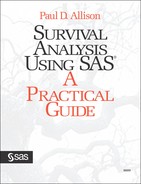Introduction
In the previous chapters, all the events in each analysis were treated as though they were identical: all deaths were the same, all job terminations were the same, and all arrests were the same. In many cases, this is a perfectly acceptable way to proceed. But more often than not, it is essential—or at least desirable—to distinguish different kinds of events and treat them differently in the analysis. To evaluate the efficacy of heart transplants, you will certainly want to treat deaths due to heart failure differently from deaths due to accident or cancer. Job terminations that occur when an employee quits are likely to have quite different determinants than those that occur when the employee is fired. And financial aid to released convicts will more plausibly reduce arrests for theft or burglary than for rape or assault.
In this chapter, we consider the method of competing risks for handling these kinds of situations. What is most characteristic of competing risk situations is that the occurrence of one type of event removes the individual from risk of all the other event types. People who die of heart disease are no longer at risk of dying of cancer. Employees who quit can no longer be fired.
Because competing risk analysis requires no new SAS procedures, this chapter will be short. With only minor changes in the SAS statements, you can estimate competing risks models with the LIFETEST, LIFEREG, or PHREG procedures. All that’s necessary is to change the code that specifies which observations are censored and which are not. After considering a bit of the theory of competing risks, most of the chapter will be devoted to examples. At the end, however, I also discuss an alternative to competing risks analysis that may be more appropriate for some situations and is equally easy to implement.
Despite the practical importance of methods for handling multiple kinds of events, textbooks often give them minimal coverage. For example Collett’s (1994) otherwise excellent survey of survival analysis only discusses competing risks in a footnote. Lawless (1982) has seven pages on competing risks out of a total of 570. Lee (1992) doesn’t even mention the topic. In this chapter, I have relied heavily on Kalbfleisch and Prentice (1980) and Cox and Oakes (1984).
